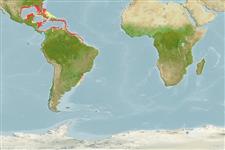Elasmobranquios (tiburones y rayas) (sharks and rays) >
Carcharhiniformes (Ground sharks) >
Triakidae (Houndsharks) > Triakinae
Etymology: Mustelus: Latin for weasel, an ancient name for sharks, possibly referring to the pointed snouts, swift movements and/or rapacious feeding behavior of smaller predatory sharks [strictly not tautonymous with Squalus mustelus Linnaeus 1758 since type was designated by the ICZN] (See ETYFish); norrisi: In honor of American zoologist Harry Waldo Norris (1862-1946), Grinnell College (Iowa), who studied the cranial nerves of the Spiny Dogfish Squalus acanthias (See ETYFish).
Eponymy: Dr Harry Waldo Norris (1862–1946) was a zoologist and anatomist who was Professor of Biology and Zoology and Curator of the Museum at Grinnell College, Iowa (1891–1931) and was Research Professor of Zoology (1931–1941), retiring as Emeritus [...] (Ref. 128868), visit book page.
Environment: milieu / climate zone / rango de profundidad / distribution range
Ecología
marino demersal; rango de profundidad 1 - 100 m (Ref. 55584), usually 3 - 40 m (Ref. 55311). Subtropical; 32°N - 36°S, 99°W - 47°W (Ref. 55311)
Western Atlantic: Florida, USA and the northern Gulf of Mexico to Venezuela; also southern Brazil.
Tamaño / Peso / Age
Madurez: Lm ? range ? - ? cm
Max length : 110 cm TL macho / no sexado; (Ref. 40637); common length : 80.0 cm TL macho / no sexado; (Ref. 5217); peso máximo publicado: 13.8 kg (Ref. 40637)
Found on the continental shelves, on muddy or sandy bottoms to about 80 m depth. Feeds on crabs and shrimps, and also bony fishes. Viviparous (with a yolk-sac placenta), with 7 to 14 young in a litter. Size at birth 30 cm.
Life cycle and mating behavior
Madurez | Reproducción | Puesta | Huevos | Fecundidad | Larva
Viviparous (with a yolk-sac placenta) (Ref. 244). Distinct pairing with embrace (Ref. 205).
Compagno, L.J.V., 1984. FAO Species Catalogue. Vol. 4. Sharks of the world. An annotated and illustrated catalogue of shark species known to date. Part 2 - Carcharhiniformes. FAO Fish. Synop. 125(4/2):251-655. Rome: FAO. (Ref. 244)
IUCN Red List Status (Ref. 130435: Version 2025-1)
Threat to humans
Harmless
Human uses
Pesquerías: escaso valor comercial; pesca deportiva: si
Herramientas
Special reports
Download XML
Fuentes de Internet
Estimates based on models
Preferred temperature (Referencia
123201): 22.6 - 28, mean 25.7 °C (based on 450 cells).
Phylogenetic diversity index (Referencia
82804): PD
50 = 0.5000 [Uniqueness, from 0.5 = low to 2.0 = high].
Bayesian length-weight: a=0.00170 (0.00097 - 0.00299), b=3.10 (2.95 - 3.25), in cm total length, based on LWR estimates for this species & Genus-body shape (Ref.
93245).
Nivel trófico (Referencia
69278): 3.9 ±0.67 se; based on food items.
Resiliencia (Referencia
120179): Muy bajo, población duplicada en un tiempo mínimo superior a 14 años (Fec=7).
Fishing Vulnerability (Ref.
59153): High to very high vulnerability (66 of 100).
🛈
